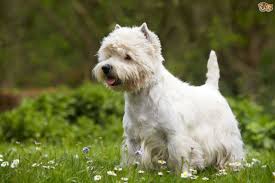West Highland White Terrier
General
The West Highland White Terrier has a shared history with the Dandie Dinmont, Scottish, Skye and Cairn Terriers, and they are all considered branches of the same breed.
This breed, known affectionally as the Westie, hails from Scotland where he was used for hunting - primarily badger, fox and otter, and also for killing mice and rats.
Edward Donald Malcolm, 16th Laird of Poltalloch, is credited with the creation of the modern breed from his Poltalloch Terrier, but did not want to be known as such and have a dog called after him and asked for the name to be changed - it then became known as the West Highland White Terrier.
This is a lovely sturdy little dog, with no lap dog tendencies, although he does love his family and being around them.
The West Highland White Terrier has a shared history with the Dandie Dinmont, Scottish, Skye and Cairn Terriers, and they are all considered branches of the same breed.
This breed, known affectionally as the Westie, hails from Scotland where he was used for hunting - primarily badger, fox and otter, and also for killing mice and rats.
Edward Donald Malcolm, 16th Laird of Poltalloch, is credited with the creation of the modern breed from his Poltalloch Terrier, but did not want to be known as such and have a dog called after him and asked for the name to be changed - it then became known as the West Highland White Terrier.
This is a lovely sturdy little dog, with no lap dog tendencies, although he does love his family and being around them.
Is this the right dog for you?
The Westie is very much the 'normal' terrier type of dog, although it is said to be less boisterous, stubborn etc, than many of the other terrier family.
Although this is a small dog, he needs a lot of exercise in order to keep him happy and not end up bored and frustrated. It is estimated at least an hour a day. The breed is very bright, but like many terriers, especially with training, he can be wilfull and demanding. A more experienced owner who works with positive reinforcement methods, and will quietly and calmly keep this little dog in line, is what is needed.
Due to what it was bred for, it can become a professional digger, especially if bored or frustrated. To satisfy the natural digging instinct, it would be a good idea to have a Digging Pit in the garden, which is kept stocked with nice goodies for added stimulation and to satisfy a nature trait.
This breed can also be barkers, especially is over excited, or bored and frustrated. Due to this it is a good idea to teach Bark & Shush when a pup and keep the practice in place.
This breed can also become very possessive of their toys and other objects, so teaching the Swap exercise when a pup and keeping it in place will avoid the problem of resource guarding developing.
Although the breed is normally friendly to people and other dogs, it can be 'otherwise', especially is early puppy socialization is not done. To ensure that your Westie will become a 'social butterfly', do make sure that early and continued socialization is done.

Should you have 2 of the same, or 2 pups together?
The Westie can get on with another Westie, however a lot of this depends on the breeding and also the dogs temperament and you must make sure that your dog has been well socialized so that it will accept another dog into the home.
When it comes to which sex get on better, your best bet is one male and one female (both sterilized), or 2 males together. Never two females. The vast majority of the time two females will get on well until about 8 - 9 months of age and them fighting for position tends to occur. When males have the odd altercation, it tends to be over quickly, but with females, it just intensifies and often the only solution is for one of the females to be rehomed. This is not just for this breed, but in general. As Westies can be otherwise to same sex dogs, if considering two, the safest would be male and female - both sterilized, and make sure a couple of months between them at least, and existing dog to be well socialized.
Having two pups from same litter is not a good idea. Most people think that the pups will be happier with a playmate and won’t fight if they are family.Your pup should be at least 5 months old, before you consider bringing in another pup. This allows the pups to grow to their full potential and not become over dependent on one another. The truth of the matter is that your two pups are likely to:
Bond with each other to the exclusion of you
The Westie can get on with another Westie, however a lot of this depends on the breeding and also the dogs temperament and you must make sure that your dog has been well socialized so that it will accept another dog into the home.
When it comes to which sex get on better, your best bet is one male and one female (both sterilized), or 2 males together. Never two females. The vast majority of the time two females will get on well until about 8 - 9 months of age and them fighting for position tends to occur. When males have the odd altercation, it tends to be over quickly, but with females, it just intensifies and often the only solution is for one of the females to be rehomed. This is not just for this breed, but in general. As Westies can be otherwise to same sex dogs, if considering two, the safest would be male and female - both sterilized, and make sure a couple of months between them at least, and existing dog to be well socialized.
Having two pups from same litter is not a good idea. Most people think that the pups will be happier with a playmate and won’t fight if they are family.Your pup should be at least 5 months old, before you consider bringing in another pup. This allows the pups to grow to their full potential and not become over dependent on one another. The truth of the matter is that your two pups are likely to:
Bond with each other to the exclusion of you
- Will stress without the other dog being around
- Fight with each other
- Be more destructive and boisterous
- Two pups together often leads to one being more assertive and the other more submissive. This could well end up in a situation where the more submissive dog will never develop its full potential.
- Mature later
Do they get on with other dogs?
West Highland White Terriers are often more tolerant toward other dogs than many other terriers are, especially dogs that belong to their own family, however many of them can be dominant and aggressive towards strange dogs. A lot of this would depend on their breeding and also their social abilities - never underestimate the difference that early, and continued socialization can make.
West Highland White Terriers are often more tolerant toward other dogs than many other terriers are, especially dogs that belong to their own family, however many of them can be dominant and aggressive towards strange dogs. A lot of this would depend on their breeding and also their social abilities - never underestimate the difference that early, and continued socialization can make.
Do they get on with other animals?
The Westie is normally a West Highland White Terriers are often more tolerant toward other dogs and cats than many other terriers are, especially dogs and cats who belong to their own family. But many Westies are still dominant or aggressive toward strange dogs.
The Westie is normally a West Highland White Terriers are often more tolerant toward other dogs and cats than many other terriers are, especially dogs and cats who belong to their own family. But many Westies are still dominant or aggressive toward strange dogs.
Are they good with children?
I do not recommend terriers for small children. Many terriers will not tolerate any nonsense from little life forms whom they consider to be below themselves in importance. Many terriers are quick to react to teasing, and even to the normal clumsiness that comes with small children (accidental squeezing of their ears or pulling of whiskers or stepping on their paw). Many terriers are possessive of their food and toys and will defend these from all comers, including children.
I do not recommend terriers for small children. Many terriers will not tolerate any nonsense from little life forms whom they consider to be below themselves in importance. Many terriers are quick to react to teasing, and even to the normal clumsiness that comes with small children (accidental squeezing of their ears or pulling of whiskers or stepping on their paw). Many terriers are possessive of their food and toys and will defend these from all comers, including children.
Health
The Westie, may be prone to KCS (Keratoconjunctivitis, patellar luxation, catarts, Legg-Perthes disease, CMO (Craniomandibular Osteopathy, and skin problems.
“In today’s age, with the rising cost of veterinary care, it really is a wise decision to consider medical insurance for your pets. Depending on the plan you choose, you can ensure that if your pet does develop one of the health issues the breed is prone too, that you will be covered –additionally, just knowing that any accident your pet may have will be covered, will out-weigh the monthly insurance fee for most pet owners. Our own personal choice is Genricpet as they have a ‘no limit’ policy and their rates are comparable to the rest of the industry. To find out the questions and things to look for in a Medical Insurance, please just follow this link”
The Westie, may be prone to KCS (Keratoconjunctivitis, patellar luxation, catarts, Legg-Perthes disease, CMO (Craniomandibular Osteopathy, and skin problems.
“In today’s age, with the rising cost of veterinary care, it really is a wise decision to consider medical insurance for your pets. Depending on the plan you choose, you can ensure that if your pet does develop one of the health issues the breed is prone too, that you will be covered –additionally, just knowing that any accident your pet may have will be covered, will out-weigh the monthly insurance fee for most pet owners. Our own personal choice is Genricpet as they have a ‘no limit’ policy and their rates are comparable to the rest of the industry. To find out the questions and things to look for in a Medical Insurance, please just follow this link”
Do’s and Dont’s
Do’s
Don’t
Do’s
- Do get your pup from a KUSA registered breeder and do read the articles on Breeders and also choosing a pup
- Sterilize at approximately 6 months of age.
- Do take your pup for socialization - pups should start at 8 weeks of age and this should not be missed - lays the foundation for future social interactions.
- Do continue the socialiazation - keeps solid social skills in place
- Give daily, regular exercise which this breed really needs.
- Supply chew toys and mental stimulation when left alone.
- Allow your dog to be part of the family
- Give regular brushing and annual vacs.
- Supply mental games such as behaviour games, scenting games etc in the garden to mentally stimulate this breed.
- Take your dog for basic training and keep simple house rules in place
Don’t
- Don't run this dog off lead in open areas.
- Don't use aversive training methods.
- Leave this breed outside alone – behaviour problems will develop


